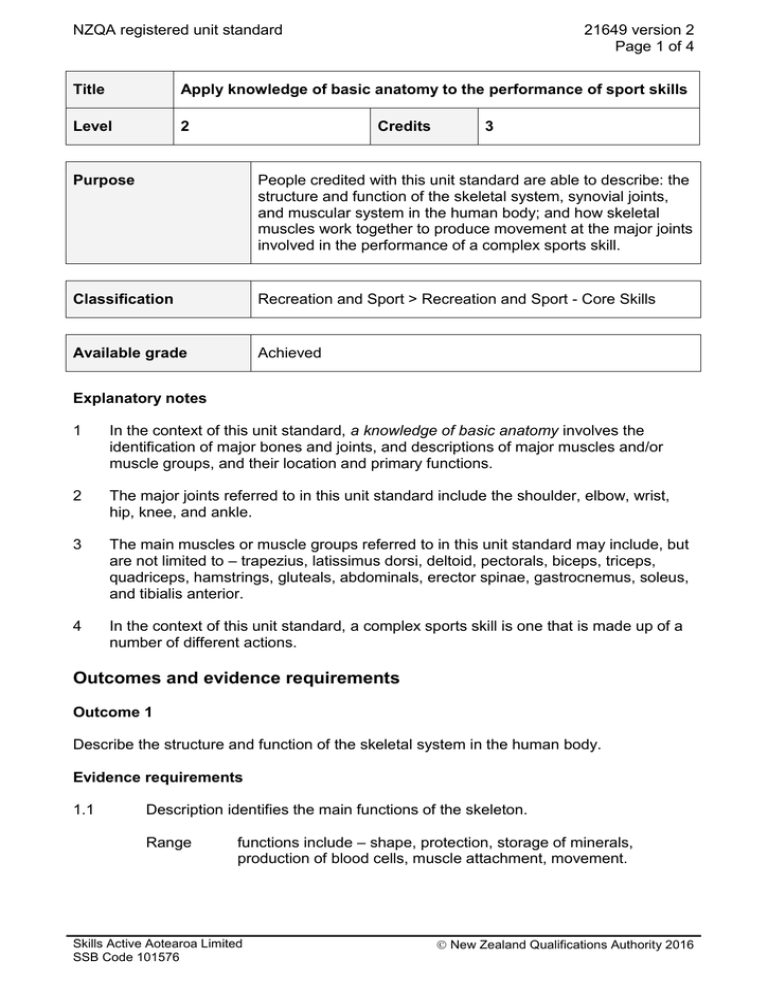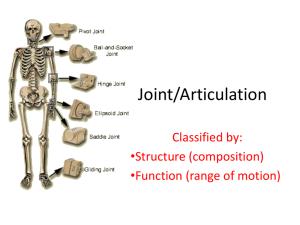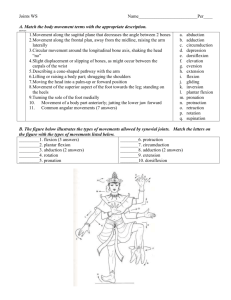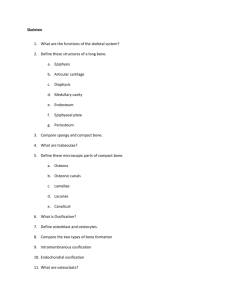NZQA registered unit standard 21649 version 2 Page 1 of 4
advertisement

NZQA registered unit standard 21649 version 2 Page 1 of 4 Title Apply knowledge of basic anatomy to the performance of sport skills Level 2 Credits 3 Purpose People credited with this unit standard are able to describe: the structure and function of the skeletal system, synovial joints, and muscular system in the human body; and how skeletal muscles work together to produce movement at the major joints involved in the performance of a complex sports skill. Classification Recreation and Sport > Recreation and Sport - Core Skills Available grade Achieved Explanatory notes 1 In the context of this unit standard, a knowledge of basic anatomy involves the identification of major bones and joints, and descriptions of major muscles and/or muscle groups, and their location and primary functions. 2 The major joints referred to in this unit standard include the shoulder, elbow, wrist, hip, knee, and ankle. 3 The main muscles or muscle groups referred to in this unit standard may include, but are not limited to – trapezius, latissimus dorsi, deltoid, pectorals, biceps, triceps, quadriceps, hamstrings, gluteals, abdominals, erector spinae, gastrocnemus, soleus, and tibialis anterior. 4 In the context of this unit standard, a complex sports skill is one that is made up of a number of different actions. Outcomes and evidence requirements Outcome 1 Describe the structure and function of the skeletal system in the human body. Evidence requirements 1.1 Description identifies the main functions of the skeleton. Range functions include – shape, protection, storage of minerals, production of blood cells, muscle attachment, movement. Skills Active Aotearoa Limited SSB Code 101576 New Zealand Qualifications Authority 2016 NZQA registered unit standard 1.2 Identification of the bones on a skeleton includes classification as axial or appendicular. Range 1.3 bones include – long, short, flat, irregular bones. Description identifies the structure and function of different types of joints. Range 1.5 skull, scapula, clavicle, vertebrae, ribs, humerus, radius, ulna, carpals, metacarpals, pelvis, femur, patella, tibia, fibula, tarsals, metatarsals. Description identifies the structure and function of different types of bones. Range 1.4 21649 version 2 Page 2 of 4 joints include – fused, cartilaginous, synovial. Anatomical reference terms are described as they relate to position and movement. Range anatomical positions include – superior, inferior, anterior, posterior, proximal, distal, medial, lateral; anatomical movements include – flexion, extension, abduction, adduction, rotation, circumduction, pronation, supination, inversion, eversion, plantar flexion, dorsi flexion. Outcome 2 Describe the structure and function of synovial joints in the human body. Evidence requirements 2.1 Synovial joints are described in relation to the structure and function of their key components. Range 2.2 Description distinguishes synovial joints according to the shape of their bones and the type of movement they allow. Range 2.3 structure of the synovial joint includes but is not limited to – ligaments, membrane, cartilage, synovial fluid. synovial joints include – ball and socket, hinge, pivot, ellipsoid, gliding or plane, saddle. Description identifies bones associated with the major joints in the human body. Range bones include – humerus, scapula, clavicle, radius, ulna, carpals, pelvis, femur, patella, tibia, fibula, tarsals. Skills Active Aotearoa Limited SSB Code 101576 New Zealand Qualifications Authority 2016 NZQA registered unit standard 21649 version 2 Page 3 of 4 Outcome 3 Describe the structure and function of the muscular system in the human body. Evidence requirements 3.1 The structure of skeletal muscle is described as it relates to function. structure includes but is not limited to – location, muscle attachments, muscle fibres, tendons; function includes but is not limited to – voluntary, types of contractions, agonist/antagonist pairs. Range 3.2 Description identifies the main skeletal muscles or muscle groups and the movements they cause in anatomical terms. Outcome 4 Describe how skeletal muscles work together to produce movement at the major joints involved in the performance of a complex sports skill. Evidence requirements 4.1 Description of the complex sports skill identifies the key movements at each of the major joints in anatomical terms. key movements may include but are not limited to – flexion, extension, abduction, adduction, rotation, circumduction, pronation, supination, inversion, eversion, plantar flexion, dorsi flexion. Range 4.2 Description identifies the actions of the main muscles or muscle groups that contribute to the movements in anatomical terms. actions include – agonist/antagonist pairs. Range Planned review date 31 December 2012 Status information and last date for assessment for superseded versions Process Version Date Last Date for Assessment Registration 1 20 November 2006 31 December 2012 Rollover and Revision 2 20 May 2011 N/A Consent and Moderation Requirements (CMR) reference 0099 This CMR can be accessed at http://www.nzqa.govt.nz/framework/search/index.do. Skills Active Aotearoa Limited SSB Code 101576 New Zealand Qualifications Authority 2016 NZQA registered unit standard 21649 version 2 Page 4 of 4 Please note Providers must be granted consent to assess against standards (accredited) by NZQA, or an inter-institutional body with delegated authority for quality assurance, before they can report credits from assessment against unit standards or deliver courses of study leading to that assessment. Industry Training Organisations must be granted consent to assess against standards by NZQA before they can register credits from assessment against unit standards. Providers and Industry Training Organisations, which have been granted consent and which are assessing against unit standards must engage with the moderation system that applies to those standards. Consent requirements and an outline of the moderation system that applies to this standard are outlined in the Accreditation and Moderation Action Plan (AMAP). The AMAP also includes useful information about special requirements for organisations wishing to develop education and training programmes, such as minimum qualifications for tutors and assessors, and special resource requirements. Comments on this unit standard Please contact Skills Active Aotearoa Limited info@skillsactive.org.nz if you wish to suggest changes to the content of this unit standard. Skills Active Aotearoa Limited SSB Code 101576 New Zealand Qualifications Authority 2016





